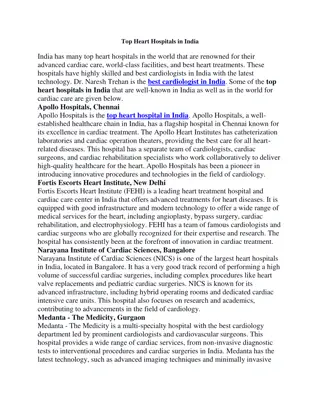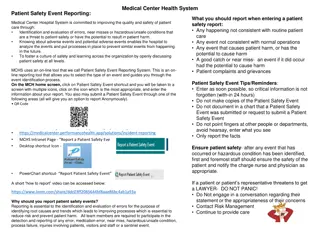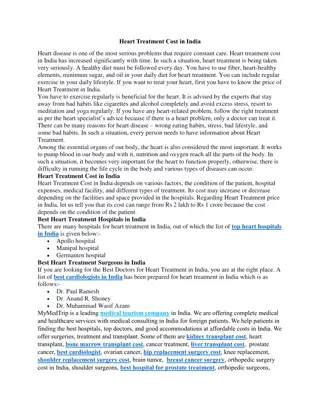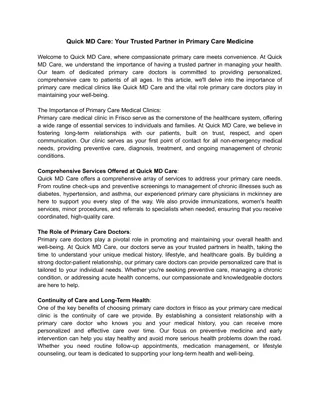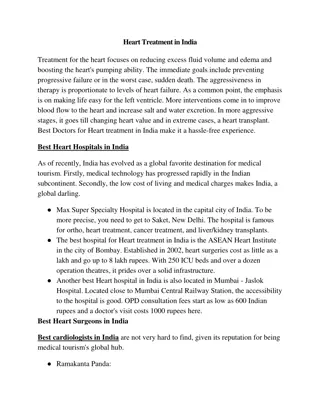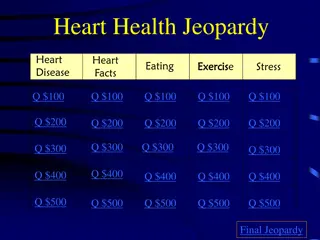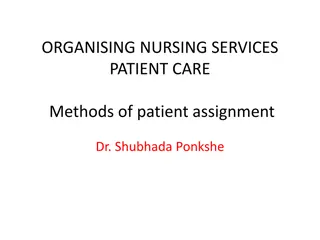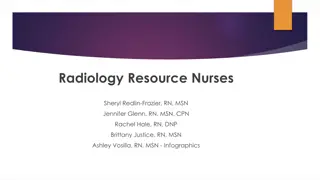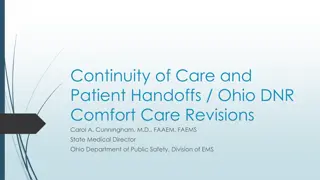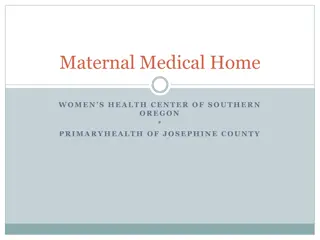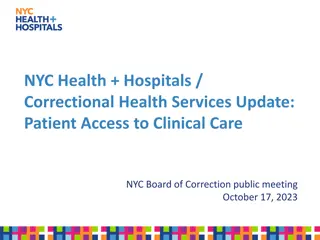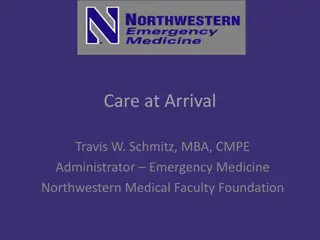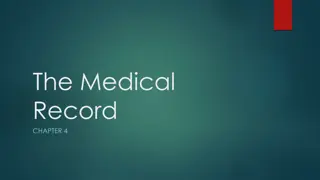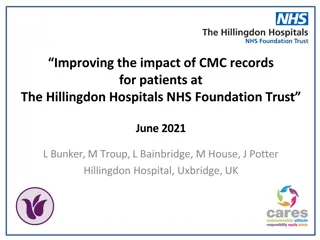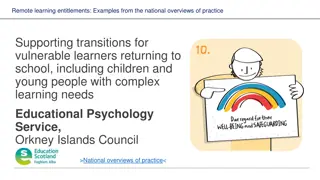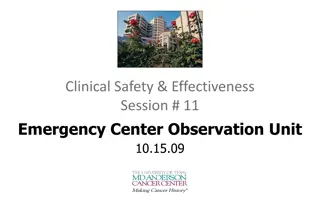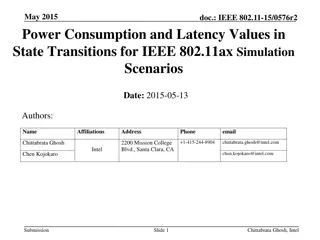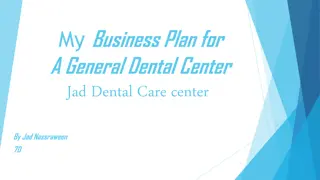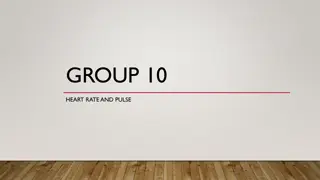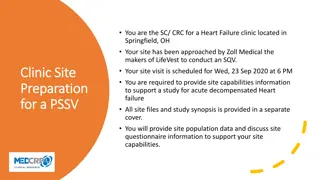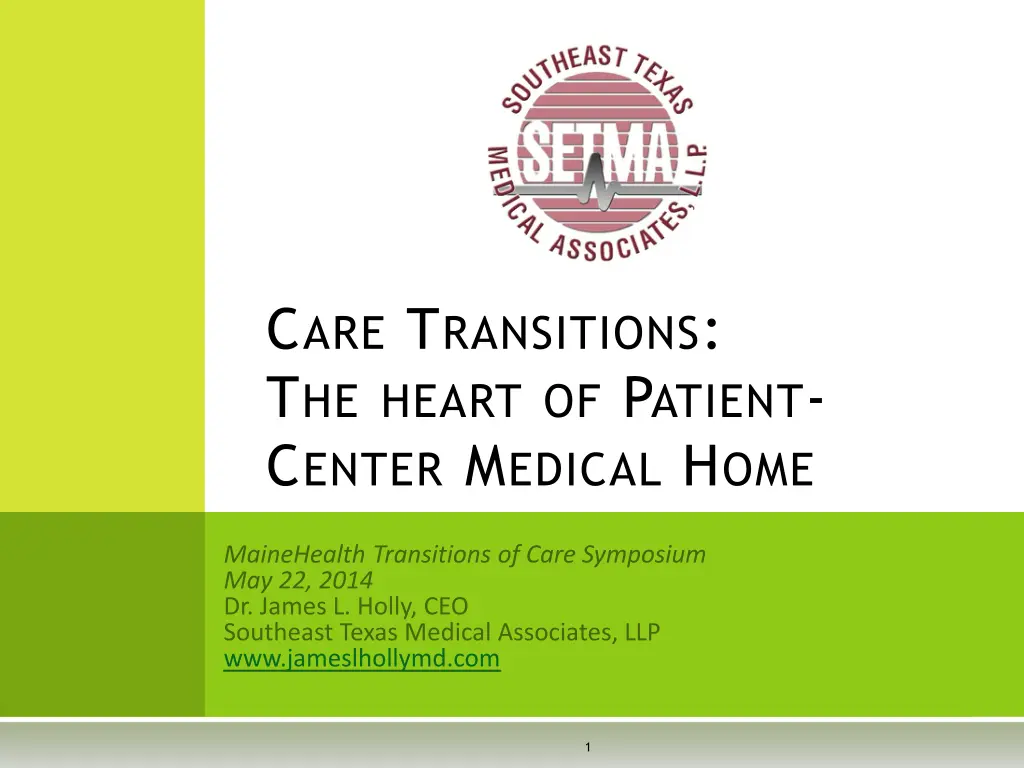
Understanding Care Transitions and Patient-Centered Medical Homes
Explore the importance of care transitions in patient-centered medical homes, focusing on evaluation at admission, care coordination metrics, post-hospital follow-up coaching, treatment planning, and more. Discover how national priorities address care coordination goals and strategies to reduce hospital readmissions effectively.
Download Presentation

Please find below an Image/Link to download the presentation.
The content on the website is provided AS IS for your information and personal use only. It may not be sold, licensed, or shared on other websites without obtaining consent from the author. If you encounter any issues during the download, it is possible that the publisher has removed the file from their server.
You are allowed to download the files provided on this website for personal or commercial use, subject to the condition that they are used lawfully. All files are the property of their respective owners.
The content on the website is provided AS IS for your information and personal use only. It may not be sold, licensed, or shared on other websites without obtaining consent from the author.
E N D
Presentation Transcript
CARE TRANSITIONS: THE HEART OF PATIENT- CENTER MEDICAL HOME www.jameslhollymd.com www.jameslhollymd.com 1
CARE TRANSITIONS InSETMA s Model of Care -- Care Transition involves: 1. Evaluationat admission --transition issues : lives alone, barriers , DME, residential care, or other needs 2. Fulfillment of PCPI Transitions of Care Quality Metric Set 3. Post Hospital Follow-up Coaching -- a 12-30 minute call made by members of SETMA s Care Coordination Department and additional support 4. Plan of Care and Treatment Plan 5. Follow-up visit with primary provider 2
NATIONAL PRIORITIES PARTNERSHIP National Priorities Partnership National Quality Forum Input to the Secretary of HHS Priorities for the 2011 National Quality Strategy Wellness and Prevention Safety Patient and Family Engagement Care Coordination Palliative and End of Life Care 3
NATIONAL PRIORITIES PARTNERSHIP Addressing the fourth NPP goal, the NQF report to HHS stated that in regard to care coordination: Healthcare should guide patients and families through their healthcare experience, while respecting patient choice, offering physical and psychological supports, and encouraging strong relationships among patients and the healthcare professionals accountable for their care . 4
NATIONAL PRIORITIES PARTNERSHIP Focus in care coordination by NPP are the links between: Care Transitions continually strive to improve care by considering feedback from all patients and their families regarding coordination of their care during transitions between healthcare systems and services, and communities. Preventable Readmissions work collaboratively with patients to reduce preventable 30-day readmission rates. 5
CARE TRANSITIONS & HOSPITAL READMISSION In SETMA s experience, there are fifteen steps required to address care coordination and hospital readmissions, as a function of a quality care initiative which is sustainable. The steps and the solution for each are as follows. 6
CARE TRANSITIONS & HOSPITAL READMISSION 1. In January,1999, SETMA began using the EHR to document patient encounters. In May, 1999, SETMA modified the goal to electronic patient management (EPM) in order to leverage the power of electronics to improve treatment outcomes. In October, SETMA began using the EMR in the hospital for hospital H&Ps, creating continuity-of- care process, based on healthcare data being electronically created and being available at all points of care. 7
CARE TRANSITIONS & HOSPITAL READMISSION 2. In 2000, realizing that excellent care in the 21st Century was going to be team-based, SETMA formed a hospital service team, which provides 24-hour-a-day, seven-day a week, in-house coverage for all of our patients. 8
CARE TRANSITIONS & HOSPITAL READMISSION 3. In 2001, SETMA began using the EHR to produce hospital discharge summaries which further advanced continuity-of-patient-care and established the groundwork both for care transitions and for effectively addressing preventable readmissions. At this point, medication reconciliation could take place in the: clinic, hospital, nursing home, home health and emergency department. 9
CARE TRANSITIONS & HOSPITAL READMISSION 4. In 2003, SETMA designed hospital-admission- order sets, based on national standards of care, which created a consistency of treatment plans and eliminated delay in the initiation of excellent care. 10
CARE TRANSITIONS & HOSPITAL READMISSION 5. Also ,in 2003, SETMA began using the EHR in all twenty-two nursing homes we staff. Because our patients care is managed in the same electronic data base, whether in the ambulatory setting, hospice, home health, physical therapy, hospital, emergency department, or nursing home, there is a continuity-of-care which is data and information driven. 11
CARE TRANSITIONS & HOSPITAL READMISSION 6. In 2004, SETMA designed an electronic, Inpatient Medical Record Census (IMRC); deployed on SETMA s intranet and HIPPA compliant, the IMRC allows searchable-data recording of: a. date of admission to the hospital b. place of admission c. date and time of completion of the History and Physical d. date of discharge e. date and time of completion of the Hospital Care summary and post-hospital plan of care and treatment plan. f. Posting of questions from business office which need research by hospital care team. 12
CARE TRANSITIONS & HOSPITAL READMISSION 7. In 2007, SETMA s partners realized that many of our patients, even those with insurance, cannot afford all of their health care. This resulted in the creation of The SETMA Foundation. SETMA partners have given over $1,500,000 to the Foundation which pays for medications, surgeries and other care, such as dental, for our patients who cannot afford it. 13
CARE TRANSITIONS & HOSPITAL READMISSION 8. In June, 2009, the Physician Consortium for Performance Improvement (PCPI) published the first national quality measurement set on Care Transitions; the same month, SETMA deployed the measures in our EHR. Since then, of the over 21,000 discharges from the hospital, 98.7% have had the Hospital Care Summary completed at the time the patient left the hospital. 14
CARE TRANSITIONS & HOSPITAL READMISSION 9. October, 2009, SETMA adapted a Business Intelligence tool to create an audit of hospitalized patients to examine differences between patients who are re-admitted and those who are not. The audit looks at: gender, ethnicity, socio-economic issues, social isolation, morbidities and co-morbidities, lengths of stays, age, timing of follow-up after discharge, whether a follow-up call was received and other issues. These measures look for leverage points for making a change, which will make a difference in readmissions 15
CARE TRANSITIONS & HOSPITAL READMISSION 10.November, 2009, SETMA began publicly reporting performance on over 300 quality metrics by provider name at www.jameslhollymd.com. As of May, 2014, SETMA has publicly reported five years and the first quarter of the sixth year on our website. Disease management plans-of-care documents for diabetes, hypertension, and cholesterol, include the provider performance on that patient s care, as judged by these quality metrics. 16
CARE TRANSITIONS & HOSPITAL READMISSION 11. In July, 2010, pursuant to becoming a Tier 3 PC-MH, SETMA created a Department of Care Coordination, which is tasked with: Post Hospital follow-up care coaching calls Completing SETMA Foundation Referrals Patient counseling for barriers to care Establishing continuity of care Activating and Engaging patients in their own care Alerting providers to patients special needs Another level of medication reconciliation Conflict and complaint resolution 17
CARE TRANSITIONS & HOSPITAL READMISSION 12.September, 2010, at NQF s workshop on Care Transitions, SETMA realized that the term discharge summary was outdated. We changed the name to Hospital Care Summary and Post Hospital Plan-of-Care and Treatment-Plan, long and perhaps awkward, this name, is functional, focusing on the unique elements of Care Transition which contribute to the foundation of a sustainable plan for addressing preventable readmissions to the hospital. 18
CARE TRANSITIONS: PATIENT ACTIVATIONAND ENGAGEMENT http://www.jameslhollymd.com/epm-tools/Automated-Team-Tutorial-for- the-EMR-Automated-Team-Function Transitions of Care Continuity of Care Patient Activation & Engagement The Automated Team 19
CARE TRANSITIONS & HOSPITAL READMISSION 13.In 2010, SETMA deployed both a secure web portal and a Health Information Exchange to allow the seamless exchange of information between hospitals , nursing homes, home health agencies, hospices, and SETMA. The HIE has been expanded to a seven-county project including all healthcare providers and agencies, which will ultimately be the key to preventing readmission to the hospital. These are the foundational tools of the Patient-Centered Medical Neighborhood. 20
CARE TRANSITIONS & HOSPITAL READMISSION 14. Since 1997, SETMA has partnered with a Medicare Advantage home health agency, with other home health agencies and with free- standing hospices to provide compassionate, competent care for our patients in settings other than hospital inpatient to reduce readmissions of our most vulnerable patients while providing excellent care to them. 21
CARE TRANSITIONS & HOSPITAL READMISSION 15. As a Patient-Centered Medical Home, SETMA makes certain that the Hospital Care Summary and Post Hospital Plan of Care and Treatment is transmitted to the next site of care as the baton, (see below). With these care coordination, continuity of care and patient- support functions, SETMA believes that we are ready to make a major effort to decrease preventable readmissions to the hospital. 22
CARE TRANSITIONS & HOSPITAL READMISSION These tools and functions have allowed sustainable improvements. For example: In February, 2011, during one weekend, SETMA discharged 26 patients in two days. Most of these discharges were challenging, but all were treated all through SETMA s standard procedures and processes described above. Over the next 60 days, 6.8% were readmitted. 23
CARE TRANSITIONS Remember, inSETMA s Model of Care Care Transition involves: 1. Evaluationat admission --transition issues: lives alone, barriers , DME, residential care, or other needs 2. Fulfillment of PCPI Transitions of Care Quality Metric Set 3. Post Hospital Follow-up Coaching -- a 12-30 minute call made by members of SETMA s Care Coordination Department and additional support 4. Plan of Care and Treatment Plan 5. Follow-up visit with primary provider 24
HOSPITAL CARE SUMMARY SETMA s Hospital Care Summary is a suite of templates with which the transition of care document Is created. (A full tutorial of these templates can be found on our website at www.jameslhollymd.com under Electronic Patient Tools at Hospital Based Tools. ) The following is a screen shot of the Master Discharge Template entitled Hospital Care Summary . This screen shot is from the record of a real patient whose identify has been removed. 25
CARE TRANSITION AUDIT At the bottom of this template, there is a button Entitled Care Transitions Audit. Once the suite of Templates associated with the Hospital Care Summary has been completed, the provider depresses this button and the system automatically aggregates the data which has been documented and displays which of the 18-data points has been completed and which has not. 27
CARE TRANSITION AUDIT The elements in black have been completed; any in red have not. If an element is incomplete, the provider simply clicks the button entitled Click to update/Review. The missing information can then be added. This fulfills one of SETMA s principles of EHR design which is We want to make it easier to do it right than not to do it at all. 29
CARE TRANSITION AUDIT Quarterly and annually, SETMA audits each provider s performance on these measures and publishes that audit on our website under Public Reporting, along with over 200 other quality metrics which we track routinely. The following is the care transition audit results by provider name for 2010. 30
HOSPITAL CARE SUMMARY Once the Care Transition issues are completed, The Hospital Care-Summary-and-Post- Hospital-Plan-of Care-and Treatment-Plan document is generated and printed. It is given to the patient and/or to the patient s family, to the hospital, to the nursing home, hospice or home health agency and to the primary care physician if he/she is not a SETMA provider. This document is the Transitions-of-Care Baton! 33
THE BATON The following picture is a portrayal of the plan of care and treatment plan which is like the baton in a relay race. A framed copy of this is displayed in all public areas at SETMA and a poster 34
THE BATON The Baton is the instrument through which responsibility for a patient s health care is transferred to the patient or family. Framed copies of this picture hang in the public areas of all SETMA clinics and a poster of it hangs in every examination room. The poster declares: Firmly in the provider s hand --The baton -- the care and treatment plan Must be confidently and securely grasped by the patient, If change is to make a difference 8,760 hours a year. 35
THE BATON The poster illustrates: 1. That the healthcare-team relationship, which exists between the patient and the healthcare provider, is key to the success of the outcome of quality healthcare. 2. That the plan of care and treatment plan, the baton, is the engine through which the knowledge and power of the healthcare team is transmitted and sustained. 3. That the means of transfer of the baton, which has been developed by the healthcare team, is a coordinated effort between the provider and the patient. 36
THE BATON 4. That typically the healthcare provider knows and understands the patient s healthcare plan of care and the treatment plan, but without its transfer to the patient, the provider s knowledge is useless to the patient. 5. That the imperative for the plan the baton is that it must be transferred from the provider to the patient, if change in the life of the patient is going to make a difference in the patient s health. 37
THE BATON 6. That this transfer requires that the patient grasps the baton, i.e., that the patient accepts, receives, understands and comprehends the plan, and that the patient is equipped and empowered to carry out the plan successfully. 7. That the patient knows that of the 8,760 hours in the year, he/she will be responsible for carrying the baton, longer and better than any other member of the healthcare team. 38
HOSPITAL FOLLOW-UP CALL After the care transition audit is completed and the document is generated, the provider completes the Hospital-Follow- up-Call document: 39
FOLLOW-UP CALL -- I During that preparation of the baton, the provider checks off the questions which are to be asked the patient in the follow-up call. The call order is sent to the Care Coordination Department electronically. The day following discharge, the patient is called. The call is the beginning of the coaching of the patient to help make them successful in the transition from the inpatient setting. 40
FOLLOW-UP CALL II The Care-Coordination, post-hospital call takes 12- 30 minutes with each patient and engages the patient in eliminating barriers to care. If appropriate, an additional call is scheduled at an appropriate interval. If after three attempts, the patient is not reached by phone, the box in the lower left-hand corner by Unable to Call, Letter sent is checked. Automatically, a letter is created which is sent to the patient asking them to contact SETMA. 41
COORDINATED CARE The genius and the promise of the Patient-Centered Medical Home are symbolized by the baton. Its display continually reminds the provider and will inform the patient, that to be successful, the patient s care must be coordinated, and must result in coordinated care. In 2011, as we expand the scope of SETMA s Department of Care Coordination, we know that the principal failure-points of coordination are at the transitions of care, and that the work of the healthcare team patient and provider is that together they evaluate, define and execute a plan which is effectively transmitted to the patient. 42
TRANSITIONOF CARE The complexity of the Transition of Care process is illustrated by this analysis of the eight different places this document can need to be sent. 43
HOSPITAL CARE SUMMARY 1. Inpatient to ambulatory outpatient (family) The "baton," in a printed format, is given to the patient or in the case of a minor or incompetent adult to a parent or care giver. The "plan of care and treatment plan" -- "the baton" -- is reviewed with the patient, parent and/or family before the patient leaves the hospital. 44
HOSPITAL CARE SUMMARY 2. Inpatient to ambulatory outpatient (clinic physician) for patients who are seen at SETMA, the "baton" is created in the EHR and is immediately accessible to the follow-up provider. 45
HOSPITAL CARE SUMMARY 3. Inpatient to ambulatory outpatient (follow-up call) -- after the Hospital Care Summary and Post Hospital Plan of Care and Treatment Plan is completed, a secure e-mail is sent to the department of Care Coordination scheduling the post-hospital, follow-up call and letting the caller know the issues which need to be addressed. 46
HOSPITAL CARE SUMMARY 4. Emergency Department to ambulatory care the same process as in "1" above. 5. Inpatient to Nursing Home -- the "baton," with a special set of Nursing Home orders, is given to the patient or family, and a copy is sent to the Nursing Home with transportation of the patient to the Nursing home. 6. Inpatient to Hospice -- the same as with number 5 7. Inpatient to Home Health -- the same as number "5 and "6" above. If the patient is seeing SETMA's home health, they have access to SETMA EHR and thus to the "baton." 47
HOSPITAL CARE SUMMARY 8. Inpatient to outpatient out of area -- "Baton" given to patient and family and also posted to web portal and HIE. token sent to health provider in remote location area, which allows one time access to this patient's information. 48
FOLLOW-UP VISIT The Transition of Care is complete when the patent is seen by the primary care provider in follow-up. Many issues are dealt with in this follow-up visit, but one of them is another potential referral to the Care Coordination Department. If the patient has any barriers to care, the provider will complete the following template. In this case, with checking three buttons, the need for financial assistance with medications and transportation is communicated to the Care Coordination Department. 49

